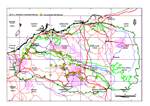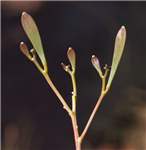Click on images
to enlarge



Photographer: B.R. Maslin

Photographer: S. van Leeuwen

Photographer: B.R. Maslin

Photographer: B.R. Maslin

Photographer: S. van Leeuwen

Photographer: S. van Leeuwen
, LSWE 7031, lab photo by Fiona McCallum ADJUSTED_sml.jpg)
Seed from one herbarium voucher. Scale in mm. Photographer: F. McCallum.
Botanical name
Acacia atkinsiana Maslin, Nuytsia 4: 75, figs 3 & 10 (1982)
Common name
Atkins' Wattle
Aboriginal name
Bilari, Bilarri or Pilarri (Kurrama)
Description
Spreading, more or less 'v'-shaped or sometimes ±rounded shrubs 1-3.5 m tall, with about 3-6 main stems arising from ground level, occasionally single-stemmed and with a spindly habit, the crowns somewhat rounded and mid-dense to rather open (becoming bushy in regrowth situations). Bark mid-grey to dark grey, smooth except longitudinally fissured at base of main stems. Branchlets terete, glabrous (but see comment under Notes). New shoots resinous. Phyllodes very narrowly elliptic to narrowly oblanceolate, broadest at or above the middle and narrowed towards the base, 6-14.5 cm long, (3-) 5-10 (-12) mm wide, coriaceous but not particularly rigid, ascending to erect, ±straight or more commonly shallowly to obviously incurved, glabrous (but see comment under Notes), grey-green or pale green with a greyish tint, with a slight silvery sheen; parallel longitudinal nerves numerous, fine, close together, of uniform prominence except the midrib and a nerve on either side of it are slightly more prominent than the rest; apex often terminated by a short, blunt, dark brown, knob-like thickening (which is most pronounced on young phyllodes). Inflorescences simple, occasionally rudimentary racemes 0.5-1 (-5) mm long; peduncles rather stout, 8-15 mm long, glabrous (but see comment under Notes); flower-heads not prolific (scattered over plants), obloid or sometimes globular, 10-15 mm long and 8-11 mm wide when fresh, mid-golden, the 70-90 flowers densely arranged. Flowers mostly 5-merous, occasionally some 6-merous; calyx very shallowly divided into broadly triangular lobes. Pods linear, flat, to 10 cm long, 4-6 mm wide, thinly crustaceous to firmly chartaceous, straight to shallowly curved, somewhat resinous but not sticky, glabrous (but see comment under Variation), greyish brown; ridged on either side by thickened margins. Seeds longitudinal in the pods, 4.5-5 mm long, 2 mm wide, shiny, dark brown to black, with a yellowish central area; aril white, folded beneath the seed.
Characteristic features
Phyllodes commonly incurved, green with a greyish tint and a slight silvery sheen, with numerous fine longitudinal nerves, often terminated at apex by a knob-like thickening (most pronounced on young phyllodes). Heads usually obloid, with numerous, densely arranged flowers. Peduncles rather stout and long (8-15 mm). Pods linear, narrow (4-6 mm wide), flat, ridged on either side by thickened margins.
Distribution and ecology
Confined to the northwest of Western Australia, mostly in the Pilbara but with a few scattered occurrence further south in the Gascoyne along the Ashburton River catchment. In the Pilbara it extends from the central Hamersley Range to the North West Coastal Highway east of Onslow. Atkin's Wattle favours rocky loam on spinifex plains and low rises, in association with a variety of species including A. ancistrocarpa and A. bivenosa. Acacia atkinsiana often forms dense, pure stands on disturbed sites such as along road verges and in burnt areas. Regeneration is from seed.
Flowering and fruiting period
Flowers have been recorded for most months of the year but the main flush appears to be around June and July. It takes about 3 months for seed to mature following flowering. Pods with mature seeds have been collected in September and October. Plants are often seen with buds, flowers at anthesis and old inflorescences occurring simultaneously.
Variation
Most specimens of A. atkinsiana are clearly glabrous on all organs. However, on a few specimen from the Mount Florance area there are minute, fine, hair-like structures on the branchlet apices, some phyllodes, peduncles and pods. It is not know what these structures are (perhaps crystals), but they can occasionally be misinterpreted as orthodox hairs.
Affinities
Acacia atkinsiana is closely allied to A. rhodophloia which is most readily distinguished by its Minni Ritchi bark and (in Pilbara plants) cylindrical inflorescences.
Notes
The phyllodes this species have been shown to contain relatively high concentrations of cyanogenic glycoside, and also probably possess an endogenous enzyme necessary for converting the glycoside into toxic hydrogen cyanide (Maslin et al. 1987). However, to our knowledge A. atkinsiana has never been incriminated in stock losses, but until its toxic potential has been more thoroughly investigated it should be regarded as a potentially dangerous species.
Kurrama peoples of the central Pilbara obtain edible grubs (pilu) from the roots of Atkins' Wattle. Galls (nhampanyu) which are formed by the larva of small wasp are also edible.
Conservation status
Not considered rare or endangered.
Origin of name
This species is named for Ken Atkins who provided valuable field data and many specimens of Acacia from the Tom Price - Paraburdoo area in the 1980's. The application of the Kurrama name Pilarri to A. kempeana by Wangka Maya (2001) is probably a mistake resulting from a misidentification a plant of A. atkinsiana.
References
Maslin, B.R., Conn, E.E. and Dunn, J.E. (1987). Cyanogenic Australian species of Acacia: a preliminary account of their toxicity potential. pp. 107-111. In: J.W. Turnbull (ed.) Australian Acacias in developing countries. Proceedings of an international workshop held at the Forestry Training Centre, Gympie, Australia, 4-7 August 1986. ACIAR Proceedings No. 16. pp. 196. (Australian Centre for International Agricultural Research: Canberra.)
Wangka Maya (2001). Kurrama Wordlist and Sketch Grammar. pp. 193. (Wangka Maya Pilbara Aboriginal Language Centre: South Hedland.)
